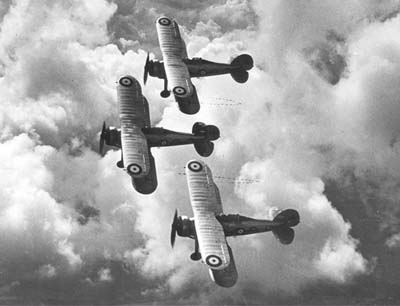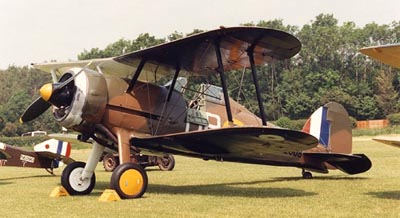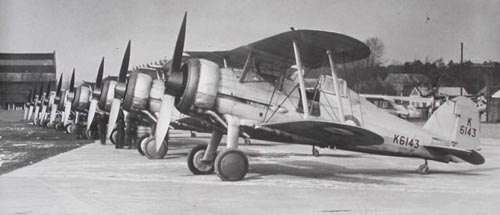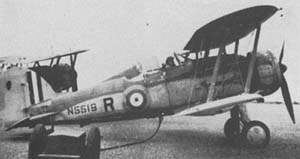 |
||||||
|
||||||
|
|||||||
 |
|||||||
| Gloster Gladiator | |||||||
The Gloster Gladiator was designed by Gloster as an updated version of their Gauntlet Fighter. It featured improved landing gears, a stronger engine and an enclosed cockpit. It went on to become the last biplane fighter of the Royal Air force. The Gladiator made its maiden flight in 1934 and was ready to enter service in 1937. At that time, the Gladiator was technically already inferior to the latest generation of monoplane fighters, like Spitfire and Hurricane or the german Me 109. The Sea Gladiator was the navy version, which was equipped with arrestor hook, reinforced landing gear struts and naval emergency equipment. |
|||||||
|
|||||||
The first Gladiators to be used in combat were those of the Chinese Nationalist Air Force, fighting against japanese Type 96 (“Claude”) and Type 97 (“Nate”) fighters after the Japanese attack on China in 1937. Even tough the chinese pilots were trained much less, they fought well against the Japanese, who were coming in superior numbers. The american born chinese John Huang and Arthur Chen became the first aces of World War 2, flying Gladiators. After the famous Type Zero Fighter was introduced, it became more and more difficult for them though. |
|||||||
|
|||||||
| The Gladiator played an important role in the Finnish Winter War against the Soviet Union. Both Finnish squadrons, as well as Swedish volunteers were flying it. Two finnish pilots, Oiva Tuominen and Paavo Berg, became aces, flying the Gladiator. The Swedish volunteers were equipped with Swedish owned gladiators, that were repainted in a winter camouflage with Finnish roundels and were refitted with ski landing gears. The Swedes scored eight aerial victories. In the Continuation War new soviet fighters became available and the Gladiators were outclassed. |
|||||||
 |
|||||||
| After the German attack on Poland, Gladiators in the front service of the Royal air force were replaced by monoplane fighters, but saw extensive use in the less important theaters of the war, used by both British forces as well as their allied forces. Royal Air Force Gladiators helped out in Norway, after the seven operational Gladiators of the norwegian air force had to yield against the tide of German aircraft, and were also used in Greece and Iraq, The opposite side in Iraq, the Royal Iraqi air force, was equipped with Gladiators as well. The only Gladiator vs. Gladiator battle ever was won by the british craft. |
|||||||
|
|||||||
| The most famous british Gladiators however, were Sea Gladiators that had coincidently been left behind by the aircraft carrier HMS Glorious on Malta. When the Italians attacked Malta in 1940, there were said to be only 3 of the 18 Gladiators airworthy. They were kept operational, using the other ones as spare parts and were equipped with three bladed propellers cannibalized from Bristol Beauforts. The Royal air force had deemed at least 4 Squadrons would be required to defend the island, but those had never arrived. The three Gladiators, which were later named “Faith”, “Hope” and “Charity” managed to hold the Italian Airforce at bay, which was flying the comparably more modern Savoia-Marchetti 79 and Macchi Castoldi 200. The Gladiators offered such fierce resistance, that the Italians estimated the number of fighters stationed at Malta to 25 aircraft. After ten days, the fascist propaganda declared the british base on Malta “utterly destroyed”. The reconnaisance plane sent to prove this, however, never returned, since it was also shot down by the Gladiators. The Gladiators struggled for almost one month until they were relieved by Hurricanes and Bombers. The Gladiator also served with a number of other Airforces including Lithuania, Latvia, Portugal, Ireland, Belgium and Greece. |
|||||||
 |
|||||||
| wingspan: 9.8m length: 8.4m height: 3.2m empty weight: 1.560kg max loaded weight: 2.205kg maximum speed: 414km/h range: 710km |
|||||||
| return to top | |||||||


